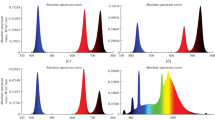Abstract
Callus cultures were derived from different parts of 8 anthocyanin producing and 2 white flowering lines of the crucifer Matthiola incana. The tissue cultures of the cyanic lines were shown to produce genotype specific anthocyanin patterns, whereas in the calli of the acyanic lines no anthocyanin synthesis occured.
Similar content being viewed by others
Abbreviations
- IAA:
-
indoleacetic acid
- 2,4-D:
-
dichlorophenoxyacetic acid
- MeOH:
-
methanol
- Et2O:
-
ether
- ETOAc:
-
ethylacetate
References
Ball EA (1972) Anthocyanins of Dimorphotheca (Compositae). I. Identity of pigments in flowers, stems, and callus cultures. Am J Bot 59: 924–930
Butcher DN (1977) Secondary products in tissue cultures. In: Reinert J, Bajaj YPS (eds) Plant cell, Tissue, and Organ culture, Springer Berlin Heidelberg New York, pp 668–693
Eriksson T (1965) Studies on the growth requirements and growth measurements of cell cultures of Haplopappus gracilis. Physiol Plant 18: 976–993
Forkmann G (1977) Die Simulation quantitativer Merkmale durch Gene mit biochemisch definierbarer Wirkung. Theor Appl Genet 49: 43–48
Forkmann G, Heller W, Grisebach H (1980) Anthocyanin biosynthesis in flowers of Matthiola incana. Flavone 3- and flavonoid 3′-hydroxylases. Z Naturforsch 35c: 691–695
Harborne JB (1967) Comparative biochemistry of the flavonoids. Academic Press, London, New York
Harborne JB (1980) In: Bell EA, Charlwood BV (eds) Encyclopedia of plant physiology, vol 8, Springer, Berlin Heidelberg New York, pp 386–391
Hemleben V, Frey M, Rall S, Koch M, Kittel M, Kreuzaler F, Ragg H, Fautz E, Hahlbrock K: Studies on the chalcone synthase gene of two higher plants: Petroselinum hortense and Matthiola incana. Proceedings of the international society of developmental biologists (in press)
Kappert H (1949) Die Genetik des incana-Charakters und der Anthocyanbildung bei der Levkoje. Züchter 19: 289–297
Leber B, Hemleben V (1979) Uptake of homologous DNA into nuclei of seedlings and by isolated nuclei of a higher plant. Z Pflanzenphysiol 91: 305–316
Negrutiu I, Beeftink F, Jacobs M (1975) Arabidopsis thaliana as a model system in somatic cell genetics. Plant Sci Lett 5: 293–304
Seyffert W (1960) Wirkung von Blütenfarbengenen bei der Levkoje, Matthiola incana P. Br. Z Pflanzenzüchtung 44: 4–29
Seyffert W (1962) Genetische Untersuchungen an Matthiola incana. Biol Zbl 81: 253–266
Seitz U, Richter G (1970) Isolierung und Charakterisierung schnell markierter, hochmolekularer RNS aus frei suspendierten Calluszellen der Petersilie (Petroselinum hortense). Planta 92: 309–314
Spribille R, Forkmann G (1981) Genetic control of chalcone synthase activity in flowers of Matthiola incana R Br. Z Naturforsch 36c: 619–624
Author information
Authors and Affiliations
Rights and permissions
About this article
Cite this article
Leweke, B., Forkmann, G. Genetically controlled anthocyanin synthesis in cell cultures of Matthiola incana . Plant Cell Reports 1, 98–100 (1982). https://doi.org/10.1007/BF00272362
Received:
Issue Date:
DOI: https://doi.org/10.1007/BF00272362




